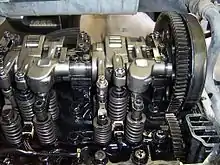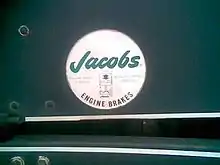Compression release engine brake
A compression release engine brake, compression brake, or decompression brake, frequently called a Jacobs brake or Jake Brake, is an engine braking mechanism installed on some diesel engines. When activated, it opens exhaust valves to the cylinders, right before the compression stroke ends, releasing the compressed gas trapped in the cylinders, and slowing the vehicle.



Clessie Cummins was granted a patent for the engine compression brake in 1965, and the first company to manufacture them was Jacobs Vehicle Systems.[1][2] The terms Jacobs brake and Jake Brake properly refer to compression brakes manufactured by Jacobs, though the terms are now become generic trademarks, and are often used to refer to compression brakes in general, especially on large vehicles and heavy equipment.
Function
When the driver releases the accelerator on a moving vehicle powered by an internal combustion engine, the vehicle's forward momentum continues to turn the engine's crankshaft. Most diesel engines do not have a throttle body, so regardless of throttle setting a full charge of air is always drawn into the cylinders (excluding the valve fitted to certain diesels, such as fire appliances and generators on oil and gas platforms, to prevent diesel engine runaway). Compressed air generated during the compression stroke acts as an air spring to push the piston back down. As such, even with fuel supply cut off and no power strokes taking place, a portion of the energy absorbed by the compression stroke within each cylinder is returned to the crankshaft. This results in very little engine braking being applied to the vehicle.
The typical compression brake consists of a hydraulic system using engine oil which transfers the motion of the fuel injector rocker arm to the engine's exhaust valve(s). When activated, the exhaust valve opens very briefly near the engine's top dead center, and releases the compressed air in the cylinder so that the energy is not returned to the crankshaft. If used properly, a compression release brake can assist a vehicle to maintain or even reduce speed with minimal use of the service brakes. The power of this type can be around the same as the engine power.[3]
In contrast, a gasoline engine under deceleration runs with a closed throttle that prevents free flow of air into the cylinders, resulting in little pressure to release at the top of the compression stroke. The closed throttle provides engine braking by forcing the engine to generate a vacuum between the throttle and the cylinders.
Typically, the controls for a compression brake consist of an on/off switch and often a selector that controls the number of cylinders on which the brake is active. Throttle and clutch switches are integral with the system. Activation occurs when both the clutch and the throttle are released with the transmission in gear. It is the driver's job to ascertain the correct transmission gear to use, depending on factors such as the steepness of the grade and the vehicle's load.
Limitations
| External video | |
|---|---|

The use of engine compression brakes may cause a vehicle to make a loud chattering, "machine gun", or "jackhammer" exhaust noise, especially vehicles having no mufflers, which has led many communities in the United States, Canada, and Australia to prohibit compression braking within municipal limits. Drivers are notified by roadside signs with legends such as "Brake Retarders Prohibited," "No Engine Brake," "No Jake Brakes," "Compression Braking Prohibited," "Please No Engine Brake," "Avoid Using Engine Brakes," or "Unmuffled Engine Braking Prohibited," and enforcement is typically through traffic fines. Such prohibitions have led to the development of new types of mufflers and turbochargers to better silence braking noise.
Jacobs claims that the use of the term "Jake Brake" on signs prohibiting engine retarding brakes violates their trademark and discriminates against Jacobs brand products.[4][5]
In the U.S. state of Ohio, state law allows a board of county commissioners or township trustees to prohibit the use of compression brakes within unincorporated areas. These local regulations apply to all state- and locally-maintained roads except Interstate highways. The state's standard "No Engine Brake" sign is designed to avoid discriminating against the Jacobs brand name.[6]
See also
References
- US 3220392, Cummins, Clessie L., issued November 30, 1965
- "Jacobs® Engine Brake Retarder" (PDF). The American Society of Mechanical Engineers. October 17, 1985. Archived from the original (PDF) on 2011-08-16. Retrieved 2010-04-30.
- Understanding Tractor-trailer Performance, page 20. Caterpillar Inc.
- "Jacobs Vehicle Systems - Noise Concerns". jake-brakes.com. Archived from the original on January 27, 2013. Retrieved August 20, 2012.
- Zolkos, Rodd (February 28, 2000). "Road signs violate trademark; Municipals urged to stop using 'Jake Brakes' brand name". Business Insurance. Crain Communications Inc. – via HighBeam Research. (subscription required)
- "Signs" (PDF). Traffic Engineering Manual (PDF). Ohio Department of Transportation. July 19, 2019 [2002]. p. 2-15. Retrieved August 23, 2019.